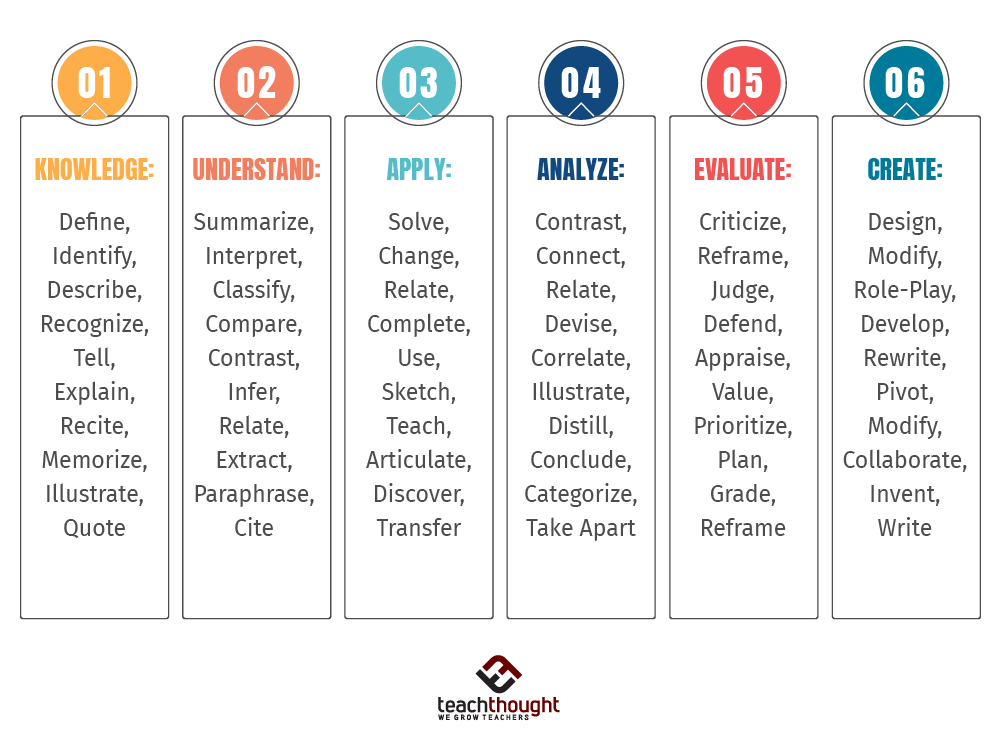Bloom’s Taxonomy Verbs (2025): Planning Verbs by Level with Classroom Examples
Summary: A current, research-informed reference of Bloom’s verbs organized by cognitive level with concise classroom examples.
Keywords: Bloom’s Taxonomy, verbs, cognitive levels, lesson planning, assessment design
This page is a practical reference for planning with Bloom’s Taxonomy.
The Goal
It organizes common planning verbs by cognitive level and pairs them with short, classroom-ready examples. The aim is not to reduce learning to a checklist. It is to give you language that helps match tasks and assessments to the level of thinking you want students to demonstrate.
Many teachers blend Bloom’s with backward design and power standards. If you are designing technology-infused tasks, you may also want our Bloom’s Digital Taxonomy Verbs.
On this page
Knowledge (Remember)
Use these verbs when the learning goal is accurate recall of facts, terms, or simple procedures. The examples are brief on purpose. You can expand them with your content, standards, and time constraints.
Verbs: Define, Identify, Describe, Recognize, Tell, Explain, Recite, Memorize, Illustrate, Quote, State, Match, Select, Examine, Locate, Enumerate, Record, List, Label
- List: List three causes of erosion from yesterday’s reading.
- Label: Label each phase of the moon on a printed diagram.
- Recall: Recite the definition of “theme” from your notes.
Understand
These verbs help students explain ideas, restate meaning, or show initial comprehension. Ask for paraphrases, comparisons, or interpreted examples rather than mere definitions.
Verbs: Summarize, Interpret, Classify, Compare, Contrast, Infer, Relate, Extract, Paraphrase, Cite, Discuss, Distinguish, Delineate, Extend, Predict, Indicate, Translate, Inquire, Associate, Explore, Convert
- Summarize: Summarize an editorial’s claim in two sentences.
- Compare: Compare two characters’ motives using a T-chart.
- Paraphrase: Paraphrase a complex paragraph to clarify meaning.
Apply
Choose these when learners must use knowledge or procedures in a new context. Good “apply” tasks include a clear product, a process to follow, and criteria for success.
Verbs: Solve, Change, Relate, Complete, Use, Sketch, Teach, Articulate, Discover, Transfer, Show, Demonstrate, Involve, Dramatize, Produce, Report, Act, Respond, Administer, Prepare, Manipulate
- Use: Use the slope formula to find slope between two points.
- Demonstrate: Demonstrate MLA book citation on an index card.
- Solve: Solve a two-step equation and check your solution.
Analyze
Analysis verbs prompt learners to break down ideas into parts and examine relationships. Ask for patterns, categories, or structures. Avoid tasks that can be completed with recall alone.
Verbs: Contrast, Connect, Relate, Devise, Correlate, Illustrate, Distill, Conclude, Categorize, Take Apart, Problem-Solve, Differentiate, Deduce, Subdivide, Calculate, Order, Adapt
- Differentiate: Separate fact, opinion, and reasoning in an article.
- Categorize: Sort lab observations as cause, effect, or noise.
- Calculate: Calculate central tendency and justify the choice of measure.
Evaluate
Evaluation requires judgment with stated criteria. Make the criteria visible and ask students to justify decisions with evidence rather than preference.
Verbs: Criticize, Reframe, Judge, Defend, Appraise, Value, Prioritize, Plan, Grade, Revise, Refine, Argue, Support, Evolve, Decide, Redesign, Pivot
- Appraise: Appraise two sources for credibility using a checklist.
- Defend: Defend a claim with three pieces of textual evidence.
- Prioritize: Rank solutions to a local issue and justify the order.
Create
Creation synthesizes ideas into an original product. Ask for audience, purpose, and constraints. Require reflection on choices made during the process.
Verbs: Design, Modify, Role-Play, Develop, Rewrite, Collaborate, Invent, Write, Formulate, Imagine
- Design: Design an experiment to test a simple hypothesis.
- Compose: Compose a narrative that reveals character through dialogue.
- Formulate: Formulate a thesis and outline arguments for a brief essay.
Printable reference (PDF)
Works Cited
- Bloom, B. S. (Ed.). (1956). Taxonomy of Educational Objectives: The Classification of Educational Goals. Handbook I: Cognitive Domain. New York: David McKay Company.
- Anderson, L. W., & Krathwohl, D. R. (Eds.). (2001). A Taxonomy for Learning, Teaching, and Assessing: A Revision of Bloom’s Taxonomy of Educational Objectives. New York: Longman.


